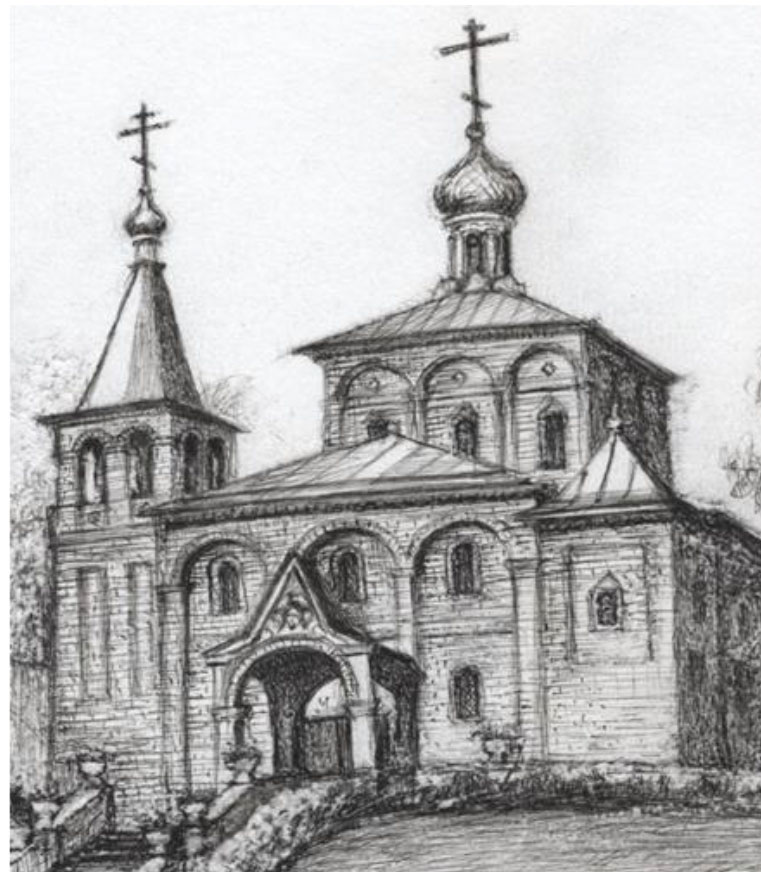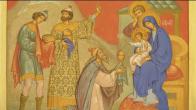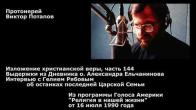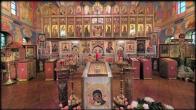You are here
St. Theodore the Sykeote
22 April/5 May
St. Theodore the Sykeote was born in the mid-6th century to a pious family in the village of Sykeon, not far from the city of Anastasiopolis, in Asia Minor. When his mother Maria conceived the saint, she dreamed that a bright star had descended into her womb. A clairvoyant elder whom she consulted explained to her that this was the grace of God, descending upon the child conceived in her womb.
When the boy was six years old, his mother gave him a golden belt, for she intended for her son to become a soldier. The Great-martyr George commemorated April 23) appeared to her in a dream, and told her not to think about a military career for her son, for the boy was predestined to serve God. Cosmas, the saint’s father, employed by Emperor Justinian the Great 527-565) as a messenger, died young. The child was left to the care of his mother. With them lived his grandmother Elpidia, an aunt named Dispenia, and his little sister Vlatta.
In school St. Theodore discovered that he had a great capacity for learning, and most importantly, a mature intellect and wisdom. He was calm and humble, could always calm down his friends, and did not permit arguments and enmity to come between them. In his mother’s home there lived the pious elder Stephen. At age 8, St. Theodore began to emulate him. During Great Lent he would eat only a small piece of bread in the evenings. To avoid having his mother force him to dine with the others, the boy would return from school only toward evening, after communing of the Holy Mysteries in church together with Elder Stephen. At the mother’s request, his teacher would allow him to go to dinner during breaks from his studies. However, St.Theodore would go instead to the church of the Great-martyr George, where the heavenly patron of the church, taking on the appearance of a youth, would come to him and let him into the church.
When St. Theodore attained the age of 12, he became gravely ill. He was carried into the church of St. John the Baptist and placed before the altar. Two drops of dew, which fell from the image of the Savior written on the church vault, healed the boy. At this time, Great-martyr George began to appear to the boy at night, and would take him to his church to pray until morning. His mother, afraid of the dangers of going on the road through the forest at night, tried to talk her son out of traveling at night. Once, when the boy had nonetheless departed, she angrily followed him to the church, pulled him out by the hair, and tied him to his bed. That same night, Great-martyr George appeared to her in a dream and sternly warned her not to forbid the youth from going to church. Elpidia and Dispenia had the same vision. The women became convinced that St. Theodore had a special calling, and they no longer prevented him from carrying on his struggle. His little sister Vlatta began to emulate him.
From that time on, St. Theodore struggled even more. During Great Lent, he would spend the first week and the week of the Cross in complete silence.
The devil decided to harm him. He appeared to the holy child in the guise of his classmate Gerontius, and tried to talk him into jumping into a pit, even jumping in himself to tempt him by example. However, the Great-martyr George, the boy’s heavenly patron, saved him.
Once the boy set off to get a blessing from elder Glicheri, a desert dweller. At the time, the country was experiencing an awful drought. The elder said, “Child, bend your knee and pray to the Lord that He send rain. In this way, we will learn whether our prayers are pleasing to the Lord.” Bending their knees, the elder and the youth began to pray, and immediately rain began to fall. Then the elder said to St. Theodore that God’s grace rested upon him, and he blessed him to become a monk at the appropriate time.
At the age of 14, St. Theodore left home and went to live at the church of the Great-martyr George. His mother would bring him food, but the saint would leave it all on the stones before the church. During the day, he would eat nothing but a single prosphora. At this young age, St. Theodore was made worthy to be granted the gift of healing. By his prayers, a possessed youth was healed.
St. Theodore avoided human glory, and went into total seclusion. Below an enormous rock near the church of Great-martyr George he dug a cave, which he entered. He then had a certain deacon fill up the entrance with earth, leaving only a small opening for air. The deacon would bring him bread and water, and would tell no one where the venerable one had hidden himself.
St. Theodore spent two years in seclusion and total silence. His relatives, thinking that he had been eaten by wild beasts, mourned for him.
However, the deacon finally took pity on the grieving mother and revealed the secret, for he feared that the venerable Theodore would die in the little cave. Venerable St. Theodore was removed, half-dead, from the cave. His mother wanted to take her son home and bring him back to health. However, the saint chose to stay at the church of Great-martyr George, and in several days had completely regained his health.
Theodosius, the local bishop, heard of the youth’s struggles. In the church of Great-martyr George, he ordained him to the rank of deacon, and subsequently to that of priest, despite the fact that the saint was only 17 years of age.
Some time later, St. Theodore went on a pilgrimage to venerate the holy sites in Jerusalem. There, in the Lavra of Joziba, near Jordan, he accepted monastic tonsure.
Upon returning to his homeland, hecontinued to live at the church of Great-martyr George. On his advice, his grandmother Elpidia, his sister Vlatta, and his mother retired to a monastery, and his aunt reposed as a confessor.
The young hieromonk’s ascetic way of life attracted to him people who were seeking salvation. The venerable one tonsured the youth Epiphanius a monk. Later, a pious woman who had been healed of illness by the saint brought her son Philoumen to him. A virtuous youth named John also came to him. Thus, gradually, brethren gathered around the venerable one.
St. Theodore continued to undergo difficult struggles. At his request, a blacksmith fashioned for him a roofless iron cage, one so narrow that he could only stand within it. Wearing heavy chains, the venerable one stood in this cage from Holy Pascha to the Nativity of Christ. From the Baptism of the Lord until Holy Pascha, St. Theodore stayed in a cave, coming out only to serve Divine Services on Saturdays and Sundays. Throughout Great Lent, the saint ate only vegetables and wheat bread, and only on Saturdays and Sundays.
Struggling in this manner, he received from the Lord power over wild beasts. Bears and wolves would come to him and take food from his hands. By the prayers of the saint, lepers were healed, and entire provinces were rid of demons. When locusts appeared in the neighboring settlement of Magatia, its residents asked Venerable St. Theodore for help. He sent them to the church. After a Divine Liturgy served by St. Theodore, they returned to their settlement and learned that in the meanwhile the entire cloud of locusts had died.
When the military leader Mavrikios was going through Galatia on his way to Constantinople after the Persian War, the venerable one prophesied that he would become emperor. The prophecy was fulfilled, and Emperor Mavrikios (582-602) granted the saint’s wish: Each year he would send bread to feed those who came to eat at the monastery.
The little church of Great-martyr George became too small to hold everyone who wanted to pray within it. Then, by the efforts of the saint, a new wonderful church was erected. At that time, the bishop of Anastasiopolis reposed. The city residents entreated Metropolitan Paul of Ancyra to make Venerable St. Theodore their bishop.
Despite his protestations, the Metropolitan’s emissaries and the residents of Anastasiopolis forcibly removed him from his cell and took him to the city.
Upon becoming a bishop, Holy Hierarch Theodore labored greatly for the good of the Church. Yet his soul yearned to commune in solitude with God. Several years later, he went to venerate the holy sites in Jerusalem. There, keeping his episcopal rank a secret, he settled in the Lavra of St. Savva, where he lived in silence from the Nativity of Christ to Pascha. Then Great-martyr George directed that he return to Anastasiopolis.
The saint’s secret enemies attempted to poison him. However, the Mother of God gave him three little seeds, and upon eating them, the holy hierarch remained unharmed. St.Theodore was oppressed by the weight of his episcopate, and asked of Cyriacus, Patriarch of Constantinople (595-606), to return to his monastery and to continue to perform Divine Services there.
The venerable one’s holiness was so evident that during his serving of the Eucharist, the grace of the Holy Spirit would descend as a bright porphyry/purple veil to cover the Holy Gifts. Once, as the saint was elevating the diskos with the Divine Lamb and was pronouncing the words “Holy things are for the Holy,” the Divine Lamb raised itself into the air, and then returned to the diskos.
Even during his lifetime, the entire Orthodox Church revered Venerable Theodore as a saint.
When, in one of the towns of Galatia, something frightening happened – during a procession of the cross, wooden crosses began to sway and break apart of their own accord – St. Thomas, Patriarch of Constantinople (607-610, commemorated 21 March) summoned Venerable St. Theodore and asked what this awful sign meant. Possessing the gift of clairvoyance, St. Theodore explained that this was a prediction of looming difficulties for the Church of God; in this manner he prophesied the coming heresy of iconoclasm. The sorrowful holy Patriarch Thomas asked that the venerable one pray that his end come soon, that he might not have to witness that misfortune.
In the year 610, St. Thomas the Patriarch reposed, having first asked St. Theodore’s blessing. In 613, Venerable St. Theodore the Sykeote also went to the Lord.PARISH LIFE
RECENT VIDEOS
Address of our Cathedral
Subscribe to our mailing list
While all the materials on this site are copyrighted, you may use them freely as long as you treat them
with respect and provide attribution on the Russian Orthodox Cathedral of St.John the Baptist of Washington DC.









